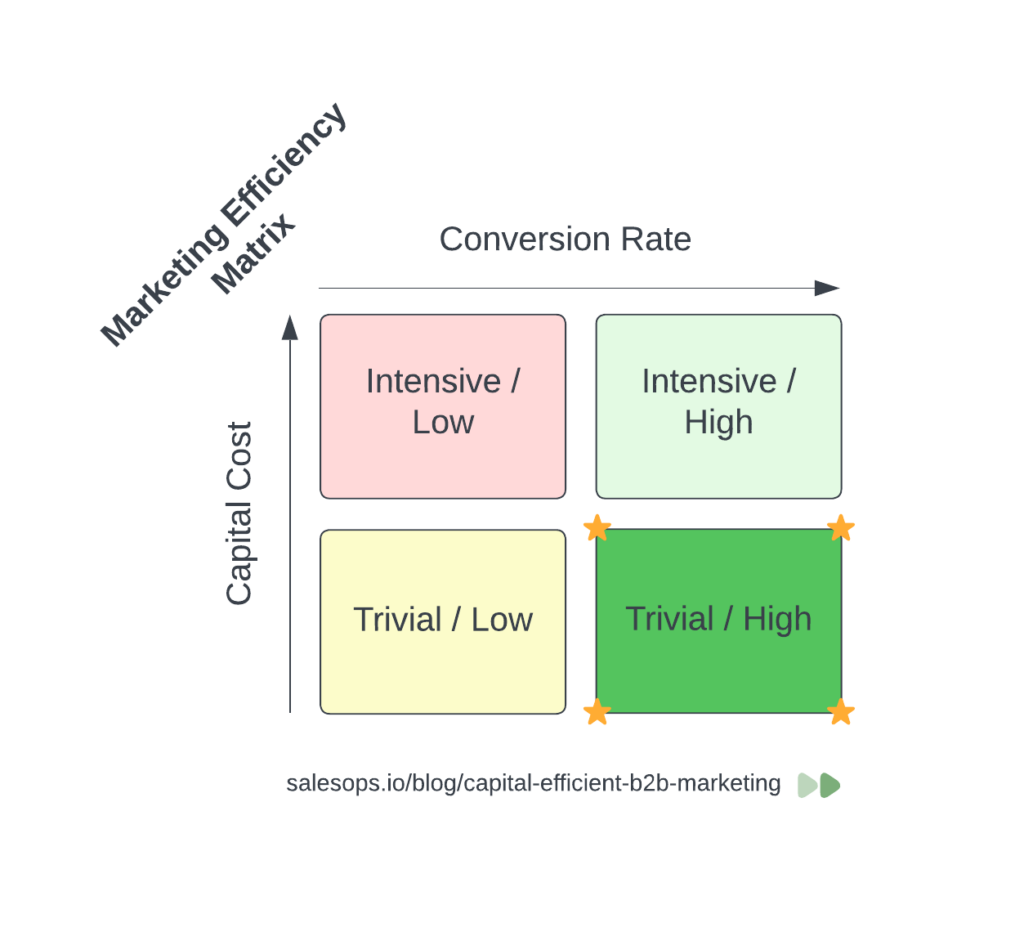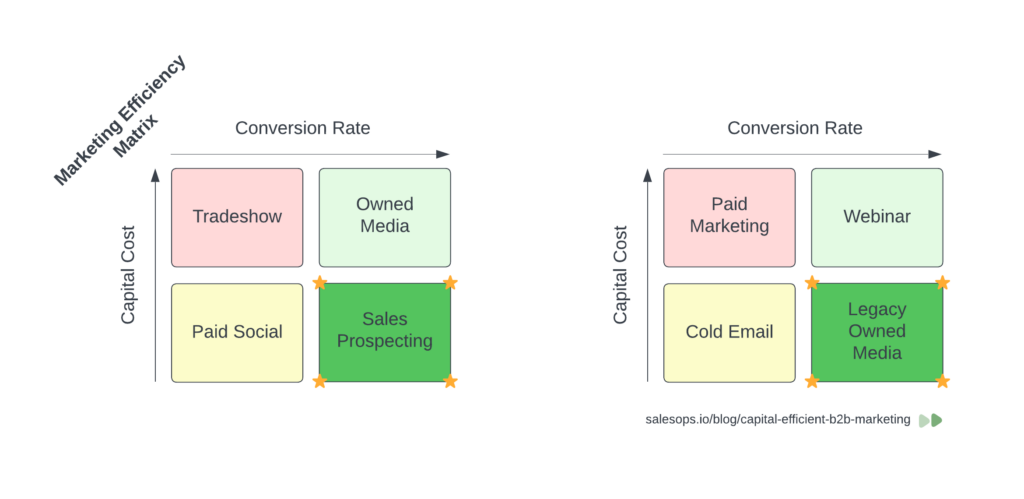Capital-Efficient B2B Marketing

Article Highlights
Capital Efficiency as Marketing Superpower
Broadly speaking, when most people use the word marketing, I suspect they’re thinking ads and brand. This is fine if you’re an established business doing billions in ARR, but it’s existentially risky if you’re an early-stage company or SMB doing $1m or less in business each year.
On LinkedIn, B2B SaaS evangelist Jason Lemkin argues for scaling your way into brand-focused marketing exercises: virtually none in the beginning and everything in the later stages. (Given their poor transactional ROI, I think it’s best to think of paid media – on and offline – as a de facto brand investment, not as a practical early-stage growth lever.)
Over the past 20 years, I’ve seen two primary things kill early-stage companies and stagnate growth at established SMBs (including the ones I’ve founded):
- over spending on digital ads
- making big commitments to sales hires without first building execution frameworks
Overinvesting in premature sales hires, digital ads, branding, and other high-funnel assets and activities bear this out: They consume precious runway and, all too often, kill early-stage businesses and stagnate SMB growth.
Capital efficiency – the amount of money, time, and resources one inputs vs. how much tangible output that creates – isn’t something most marketers think about. But they do themselves, their teams, and their stakeholders quite a service when they build campaigns and strategies with capital efficiency in mind. This is especially true for early-stage businesses and SMBs.
Consider the following 2×2:

It plots capital cost on the Y axis and conversion rate on the X axis.
Every marketing exercise – webinars, events, ads, organic content – has a capital cost and a typical conversion rate. For example, a lead from an in-person event is extremely capital intensive. They involve event fees, opportunity costs, per diems, travel time, and a host of other tangible and intangible costs. Conversely, most organic/SEO-sourced leads are far less capital intensive (especially after initial research and implementation).
Thinking in these terms puts marketers in a more complex, nuanced frame of mind. Not only are we trying to maximize raw ROI, we’re also asking, “Which leads/channels are most capital efficient?” That is, considering all inputs — human time, travel/preparation costs, risks, opportunity costs, long-term support, etc. — which marketing exercises maximize the delta between ROI and total capital expenditure?
Obviously, capital intensive / high conversion channels are good. But capital trivial / high conversion channels are best. (That’s marketing’s holy grail, really.) Capital intensive / low conversion channels are very bad, and capital trivial / low conversion channels are ok assuming they’re low touch.
Here are two examples of where specific channels typically lie:

This may differ for your organization.
You may, for example, self-manage a modest paid social campaign while committing large amounts of talent to owned media. Conversely, you may work with a high-cost agency or DCO tool and do very little owned media creation. By and large, though, paid media and IRL events like tradeshows will be far more capital intensive than content pure plays. And I think the 2×2’s implied conversion rate expectations – for both meetings and new customers – are broadly accurate across enterprises and industries.
Wherever you plot your company, I think this approach can help calibrate capital and identify overlooked gems. For example, if your marketing team is expending a lot of capital on webinars but the conversion rate is low, you’d want to throttle those down. Perhaps sales prospecting has a lower total ROI than owned media, but it’s more capital efficient than your owned media efforts.
However this applies to the specifics of your business, if you’re an early-stage company or SMB generating $1m ARR or less, the key goal here follows:
- Avoid high-cost, low ROI marketing exercises focused on paid digital, events, and branding exercises.
- Embrace low-cost, high ROI marketing exercises focused on cold outreach and evergreen owned media.
Marketing’s Holy Grail
Naval Ravikant has an (in)famous tweet where he argues, “You’re doing sales because you failed at marketing. You’re doing marketing because you failed at product.”
There are many ways to read this tweet: Make something people want. Build products with self-evident value. Build products people can discover, understand, and adopt without any special additional effort.
I think Naval’s tweet also supports the idea that product-led growth strategies (PLG) are the true holy grail of business growth. These work extremely well in a B2C context – think, Hotmail’s famous “PS: I love you” link – but there are several notable B2B examples as well. If you’re a service business, though, or if you have a product that’s insensitive to virality or network effects, you’re going to need to lean on marketing and sales.
In this reality, as the 2×2 above illustrates, I think cold sales outreach and content are marketing’s holy grail, especially for early-stage businesses and SMBs. They each have a low capital cost and a relatively high conversion rate.
In many ways, cold sales outreach is a content exercise. We use cycles of outreach to fine-tune both persona definition (“Who are we trying to reach?”) and messaging/content (“What words and value props will resonate with these personas?”). My recent Supercharge Growth webinar is a deep dive into cold sales outreach. And while there’s a good bit of interplay between the two – front-line sales intel can support content strategy, and content assets can support front-line sales efforts – in this post, I want to focus on developing effective owned media.
The following tips should help you frame and execute a compelling offering (or series of offerings).
Content-Interest Fit
In a B2B context, the best performing content tends to be built around a simple question:
“What can I create that addresses a high-demand topic that (a) is really important to a customer persona and (b) isn’t answered satisfactorily elsewhere?”
Similar to product-market fit, we might say a content asset that satisfies both criteria achieves a sort of “content-interest fit” (CIF). CIF lends marketing assets an evergreen quality that drives a lot of organic discovery and engagement across time.
Like a great film or book, really effective, valuable organic marketing content that achieves CIF endures with very little upkeep across time. And after initial creation time and expenses, organic content generally has very little capital overhead beyond the minimal costs of hosting and maintaining a website, which most businesses are going to support as a routine cost of doing business anyway.
The often unacknowledged capital savings associated with achieving organic CIF have enormous value for businesses. Marketing assets that achieve CIF are very capital efficient and convert leads at a very high rate and do so for a very long time. This capital light / high conversion ratio makes them marketing’s holy grail.
HubSpot’s Website Grader is a legendary CIF marketing asset. And it may be that your business can build a similarly popular monolithic tool for your audience. However, in many cases, you may not have the technical resources to build an interactive tool. Or you may find you need SEO exposure to many different keywords to create a sort of hydra personalization effect.
In these cases, you’ll want to create landing pages and content assets that can be “franchised.”
Franchised content can take three forms:
- One core asset can create a “zoom-out” franchise. For example, the popularity of GoConvert’s Chinese marketing guide led to the creation of hundreds of similar guides focused on other parts of the world. These generate dozens of relevant leads each month for < $100/mo (ie., the cost of hosting the site).
- One asset can also create a “zoom-in” franchise. For example, GoConvert shattered our popular list of digital marketing benchmarks into a thousand different pieces and deep dives that help us capture niche interests and searches (eg. “Spotify CTR benchmarks,” “CTR Google Ads,” &c). This has the same low-cost, set-it-and-forget-it capital structure as the international marketing guide zoom out.
- Long-duration, installment content can also satisfy the franchise concept. This would include things like an interview series (eg., Authority Magazine), including quotes in articles with relevant thought leaders (eg., Databox’ blog posts), and “top 10” lists focused on niches and particular subjects (eg., Fupping Media’s network of sites).
- This kind of content can be more or less capital intensive, depending on the medium you choose (text interviews < podcasts). But connecting with relevant thought leaders and featuring them in your content virtually ensures these professionals will share the content with their networks. This will amplify reach, lend authority, and otherwise fuel discovery and engagement.
Using AI
Post-ChatGPT, any article about marketing content probably needs to include a discussion about AI.
My cornerstone thinking follows:
AI does offer marketing teams a great way to volumize content creation, but we want to do this in an effective, ethical way. A vigorous creator economy matters, and human beings still create the content that engages other humans best. Like any other intimate romance, there’s a strong emotional resonance between content creator (writer/filmmaker/designer/&c) and content consumer (reader/viewer/witness/&c). We read, watch, and look because we want to connect with other people and learn from their experiences. Bots don’t yet offer the same potential for authentic connection.
The past can offer us a guide here:
In the 1920s, 30s, 40s, and 50s, American and European writers looked to legendary editors like Maxwell Perkins and Malcom Cowley and as helpmates. The Great Gatsby, The Sun Also Rises, Faulkner’s stories and novels, Beat poetry – Cowley and Perkins helped authors connect with readers and turn good manuscripts into great books.
Let’s approach LLM tools in a similar fashion.
For example:
🚫 Bad/Lazy Prompt: “Write me a 750-word blog post about topic X.”
This would be like Fitzgerald telling Perkins, “Write Tender is the Night for me.”
✅ Good/Engaging Prompt: “Can you give me feedback on this paragraph I wrote?”
Like Cowley and Perkins, tools like ChatGPT can act as highly-effective writing partners who can check technical accuracy, challenge sloppy thinking, and turn so-so ideas into powerful insights. In other words, AI can help marketers make their content the very best it can be. It can give feedback that will help marketers find the most effective “franchise” or interactive tool for their audiences. And it can help ensure these marketers create high-value content that engages audiences, converts leads, and does so in a capital-efficient way.
Just don’t use AI to avoid doing the critical human work. Those inputs still – and likely always will – matter. I’m bullish on the value of AI and human creativity as a partnership. I’m terrified about AI as a replacement for authentic human creative work.
Like any other bespoke, handcrafted product, human content expressions have an authentic aurora and a level of insight that’s missing from pure AI generated content. (Echoing Hemingway, we still need people to sit down at keyboards and bleed. LLMs can’t do that for us any more than they can build muscle mass for us.)
Use LLMs to amplify and improve the things you build. Don’t let them rob you of your creative agency. Don’t give away the unique power you have to express something about the human condition (both inside and outside the marketplace).
Don’t let LLMs interrupt one of the longest running experiences of humanity: bringing people together around the warmth of stories and ideas. Let’s keep hunting for insights together, discovering new ways of doing things, and passing knowledge down through tribal time to the great-great grandchildren we’ll never meet.
Email Marketing Operations
Ensuring Compliance in Marketing and Sales Communications
Thu Jun 06, 2024
Digital Data Marketing Operations Martech
Dial It In: Take Control of Your Digital Data
Wed May 08, 2024





